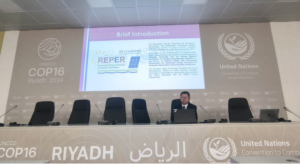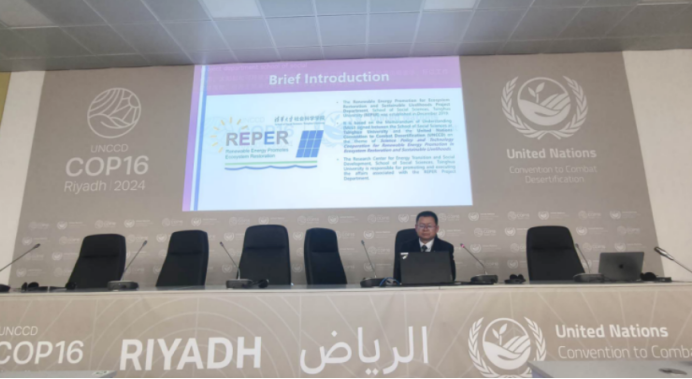[International Energy Network Live Report] A side event titled “Solar empowers land and People from scarcity to prosperity Integrated Solutions for water, food and ecosystems” was held at the China Pavilion of the 16th Conference of the Parties to the United Nations Convention to Combat Desertification (UNCCD) (COP16) in Riyadh, Saudi Arabia on December 9th.
Flood and drought risks are increasing and are likely to harm the poor disproportionately, which highlights the importance of cooperative management of shared water resources. For the current development dilemma facing the global drylands, an integrated solution combining solar energy and sustainable land management may be a viable option.
This event will bring scientists, policymakers, private sectors, and practitioners together to present scientific evidence on the multiple benefits of scientifically well-designed model of co-development of SLM and solar energy, including smart water management and irrigation systems, and agriculture restoration, thus effectively alleviating land degradation and drought. Sharing the emerging cases of co-development in different regions and demonstrating their technical innovations and contributions to the transition from scarcity to prosperity in a nexus view, through enhancing development of rich solar, improving efficiency and saving scarce water, and restoring degraded land and biodiversity, panel discussion and interactive dialogue with audience to reveal the gaps in technology, financing, policy and cross-sector coordination, and explore potential incentives for private sector’s investment in its scaling-up and assessment of its environmental impacts.
During the meeting, Dr. He Jijiang, deputy director of the Center for Energy Transition and Social Development of the School of Social Sciences of Tsinghua University and director of REPER Programme Department, summarized the work of the REPER group and issued “Solar empowers Land and People Action Plan” Riyadh Declaration.

He Jijiang, deputy director of the Center for Energy Transition and Social Development of the School of Social Sciences of Tsinghua University and director of REPER Programme Department
He Jijiang said: “We all agree that photovoltaics are the most widely distributed renewable energy in the world and are also a rich resource in arid areas; photovoltaic power generation has become the cheapest and most accessible power resource in arid areas; photovoltaics can enable people in arid areas to access electricity in the form of off-grid power sources; photovoltaics can directly benefit people in desert areas in a distributed form, which is conducive to fair transformation; in the process of arid areas striving to achieve the various goals of SDG2030, photovoltaics will not only help achieve SDG7-renewable energy for all, but also form a wide range of synergies with multiple SDG goals.”
In order to achieve the goals faster, He Jijiang proposed the following action directions:
Accelerate the electrification of people’s lives in arid areas based on off-grid photovoltaics. The minimum goal is one photovoltaic lamp per capita, one kilowatt of photovoltaics per household, one electric tricycle per household, and one mobile energy storage device per household. The higher goal is to achieve household electrification based on photovoltaics and mobile energy storage.
Promote the electrification of production activities in arid areas based on off-grid photovoltaics. This requires us to promote off-grid photovoltaic water pumps, off-grid sewage treatment machines, off-grid condensate machines, off-grid electric tools, off-grid small and micro agricultural machinery, and off-grid agricultural equipment (such as shellers, flour mills, etc.) in areas where the power grid has not reached.
Promoting the combination of photovoltaics and grid-type energy storage can help achieve the coordinated growth of “water-energy-food” in agricultural production, and help build 100% renewable energy-powered villages, towns and even urban microgrids in residential areas.
In areas with grid access conditions, people in arid areas can share part of the benefits of photovoltaic power generation by leasing land to photovoltaic power generation companies. Grid-connected household photovoltaics in arid areas can achieve photovoltaic power generation. By selling photovoltaic power to power grid companies to obtain income, it has become a new source of income for arid areas.
Grid-connected photovoltaic power stations in arid areas must adopt eco-friendly designs and establish a full-process management system from design, construction, and operation and maintenance to minimize the negative impact of photovoltaic power station construction and operation and maintenance on soil, vegetation, and biodiversity, and create ecological benefits as much as possible.
When building photovoltaic power stations in arid areas, you can choose land composite utilization modes such as agricultural photovoltaic integration, fishery photovoltaic integration, pastoral photovoltaic integration, and livestock photovoltaic integration. While ensuring the amount of photovoltaic power generation, the land can produce a certain amount of agricultural output, increase the agricultural product harvest and related agricultural income of the people in the arid areas.
Arid areas with vast land resources can benefit from the investment pull and low-cost green electricity advantages brought by the construction of photovoltaic bases, cultivate a new green industrial system, and promote local employment. Then create a zero-carbon industrial park and drive the comprehensive upgrading of the local economy and society.
He Jijiang pointed out that the units that agree with the “Solar empowers land and People” initiative and participate in the joint signature will actively carry out the following actions:
- As an enterprise, actively develop and promote photovoltaic products suitable for arid areas, and actively participate in the construction of photovoltaic power stations and the coordination with SDG goals.
- As a research institution or non-profit organization. Assist in the promotion of photovoltaic products in arid areas through research, popular science, capacity building, consulting services, etc.
- Carry out knowledge popularization activities based on photovoltaic demonstration projects of this organization or in cooperation with relevant institutions.
- Actively participate in creating the benchmark project of “Solar empowers land and People”. Create an integrated green zero-carbon system of “Energy-Water-Soil-Vegetation” for nature reserves or ecological demonstration areas; for rural villages, create zero-carbon villages with zero-carbon electricity, zero-carbon heat, zero-carbon transportation, and zero-carbon cooking.






